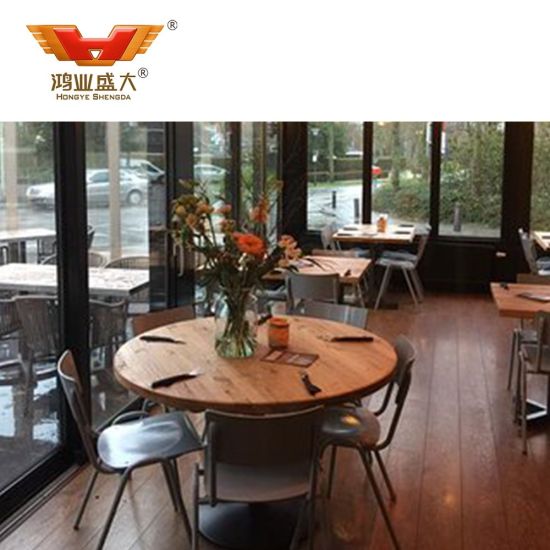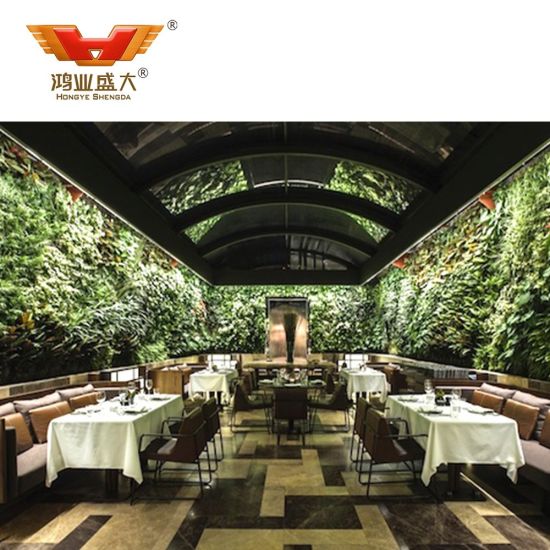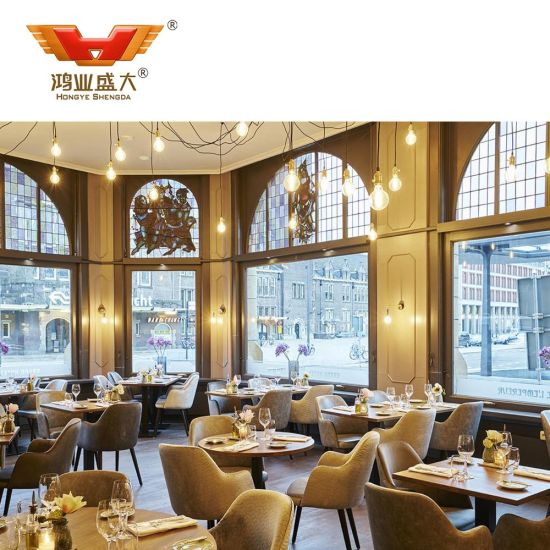Views: 0 Author: Site Editor Publish Time: 2025-04-13 Origin: Site










Restaurant furniture encompasses essential elements including chairs, tables, booths, sofas, barstools, and bar counters. They form the backbone of any dining establishment, significantly influencing customer experience. We understand these pieces do more than provide seating—they establish your venue's ambiance, ensure patron comfort, and enhance operational functionality. When planning your establishment, one question invariably arises: How much does restaurant furniture cost? This crucial investment varies widely based on materials, design complexity, manufacturing origin, and quality standards. In this guide, we’ll break it down so you can make informed, cost-effective decisions.

Restaurant furniture is more than just décor—it’s a long-term investment that impacts everything from your budget to customer satisfaction.
High-quality furniture may cost more upfront, but it often lasts longer and reduces replacement expenses. Choosing wisely helps stretch your budget and maximize return on investment (ROI).
What customers see and feel when they enter your space speaks volumes about your brand. Stylish, well-crafted furniture enhances your image and sets the tone for the entire dining experience.
Comfortable seating leads to longer stays and repeat visits. The right layout also improves traffic flow and optimizes space—boosting overall efficiency.
| Factor | Impact on Cost |
|---|---|
| Material | Polypropylene ($50-250) < Metal ($90-300) < Laminate ($75-250) < Wood ($90-500) < Marble/Granite (Premium) |
| Design Complexity | Additional features like buttoning, curved backs, and intricate carvings significantly increase manufacturing expenses |
| Customization | Branding elements, unique sizing, and specialized layouts add 15-30% to base prices |
| Quality & Durability | Higher-grade materials and superior construction techniques demand premium prices but offer extended longevity |
| Origin | Asian manufacturing typically costs 30-50% less than European counterparts due to quality control standards |
| Brand Premium | Designer labels often command 40-100% higher prices for similar quality items due to reputation and royalties |
Understanding these factors helps you make informed decisions that balance your budget constraints with aesthetic and functional requirements.
Restaurant furniture comes in many forms, and each category has its own pricing scale depending on materials, design, and functionality. Here's a detailed breakdown to guide your planning.

Custom Made Hotel Tables and Chairs for Restaurant
Chair selection dramatically influences both your budget and venue aesthetic. The price spectrum includes:
| Chair Type | Price Range | Key Cost Factors |
|---|---|---|
| Polypropylene | $50-$250 | Design complexity, mold sophistication, country of origin |
| Metal | $50-$200+ | Material type (steel vs. aluminum), finish quality (chrome, powder coating) |
| Upholstered | $90-$1000+ | Frame material, upholstery grade, detailing (buttoning, curved features) |
| Timber | $90-$500+ | Wood species (European Beech vs. Rubberwood), construction method |
Tables typically require separate budgeting for tops and bases:
Laminate tabletops ($75-$150+): Economical for commercial settings, with price varying by thickness
Wood tabletops ($130-$250+): Pricing reflects timber source and density
Premium tabletops ($200-$2000+): Materials like reclaimed wood, marble, or granite command substantial premiums
Table bases: Range from basic cast iron ($40-$150) to specialized outdoor versions with self-leveling capabilities ($100-$300)
Your venue may benefit from diversified seating options:
Booth seating (starting ~$200): Cost varies with wood density, upholstery quality, and customization requirements
Restaurant sofas: From vinyl/rexine ($120) to premium leather options ($250+)
Barstools: Basic counter-height ($35+) to designer options ($120+)
For establishments featuring bar service, counter investments typically scale with complexity:
Simple wooden design (18ft): $4,000
Modern/contemporary styling: $5,300
Premium finishing and features: $6,200
When evaluating these price ranges, it’s important we consider durability, visual appeal, and the long-term value each piece offers. A thoughtful mix of affordable and premium items can often deliver both style and sustainability.

Custom Design Fast Food Restaurant Table and Chair
Choosing where to buy your restaurant furniture is just as important as selecting the right pieces. Each sourcing option comes with its own advantages and trade-offs. Here’s how we can weigh them:
| Sourcing Option | Advantages | Limitations | Best For |
|---|---|---|---|
| Direct Factory Manufacturers | • Comprehensive selection • Volume discounts • Customization options • Consistent quality standards • Direct communication with producers | • Minimum order requirements (typically 60+ seats) • Significant shipping costs • Longer lead times for custom orders • Inability to physically inspect before purchase | • Larger establishments • New restaurant openings • Chain locations requiring consistent furnishings • Venues with specific design requirements |
| Local Vendors/Carpenters | • Physical product inspection • Simplified logistics • Relationship-based service • Support for local businesses • Potential for minor customizations | • Generally higher unit pricing • Limited selection compared to manufacturers • Inconsistent commercial durability standards • Extended production timelines for custom work | • Smaller independent venues • Restaurants with unique aesthetic requirements • Establishments with flexible opening timelines • Businesses prioritizing local sourcing |
| Used Restaurant Furniture | • Significantly reduced acquisition costs • Immediate availability • Environmentally sustainable option • No manufacturing lead time • Potential for vintage or unique pieces | • Inconsistent inventory availability • Variable condition and remaining lifespan • Limited warranty protection • Potential hygiene considerations • Aesthetic consistency challenges | • Pop-up concepts • Extremely budget-conscious operations • Venues with rustic or eclectic design themes • Temporary locations • Quick-service establishments |
When evaluating these options, we suggest requesting samples when possible, thoroughly examining warranty terms, and calculating total acquisition costs including shipping, assembly, and potential maintenance requirements. Many establishments benefit from a hybrid procurement approach, sourcing signature pieces from quality manufacturers while complementing with secondary items from alternative channels.
When budgeting for restaurant furniture, the purchase price represents only a portion of your total investment. Several additional expenses warrant consideration in your financial planning.
| Cost Category | Description | Budget Impact |
|---|---|---|
| Shipping & Delivery | Restaurant furniture shipments often require specialized handling due to size and weight. Many manufacturers offer private delivery services that can add hundreds or thousands of dollars to your investment depending on volume and distance. | 10-20% of purchase price |
| Assembly & Installation | Many restaurant furniture items arrive unassembled, requiring either significant staff time or professional installation services. Tables typically need bases attached to tops, and some complex pieces may require specialized skills for proper assembly. | $25-50 per piece for professional assembly |
| Maintenance & Repairs | Commercial furniture endures significant wear in high-traffic environments. Regular maintenance including tightening screws, sanding surfaces, and refinishing may be necessary to maintain appearance and structural integrity. | 5-15% of furniture cost annually |
| Replacement Planning | Even quality furniture eventually requires replacement. Planning for cyclical furniture updates helps prevent unexpected capital expenditures and maintains your establishment's aesthetic appeal. | Partial replacement every 3-5 years |

Custom Made Cafe Restaurant Furniture
Furnishing a restaurant doesn’t have to break the bank. With smart planning and strategic choices, we can create a stylish, functional space without overspending. Here are some cost-saving tips that work:
Trendy pieces may look great now, but if they don’t hold up, we’ll end up replacing them sooner. Investing in durable materials like solid wood or metal offers long-term value.
We don’t need to stick to a single collection. Combining affordable pieces with a few standout items creates visual interest and helps manage costs.
Opt for tables with storage, stackable chairs, or benches that maximize space. These dual-purpose pieces reduce the need for extra furniture.
Most suppliers offer volume pricing. If we’re furnishing 60+ seats, it’s worth negotiating a better rate or requesting package deals.
Furniture is a major investment—so it should be part of the initial financial plan. We must account not only for purchase prices but also for shipping, assembly, and future replacements.
Restaurant chairs cost $50-1000 depending on materials. Tables range from $75-2000+ for tops, with bases adding $40-300.
Quality furniture lasts longer, reducing replacement needs. The cheapest options often cost more over time.
Choose pieces based on your restaurant's specific needs rather than current trends.
Prioritize function, comfort, and durability. These factors ultimately deliver better value for your investment.
HONGYE is a renowned furniture manufacturing enterprise with over 30 years of industry experience. Founded in Yongkang, Zhejiang, and now thriving in the Sino-European SME International Cooperation Zone-Heshan Industrial City. HONGYE research and development, production, sale and sales after service.
What is the average cost to furnish a restaurant?
Total furnishing costs vary based on seating capacity and quality tier. For a 60-seat restaurant, budget approximately:
Economy tier: $15,000-$25,000
Mid-range tier: $30,000-$45,000
Premium tier: $50,000-$80,000
These estimates include chairs, tables, booth seating, and basic decor elements.
How much should I budget for restaurant chairs?
We recommend allocating $90-$150 per chair for durable commercial-grade seating. While economy options start at $50, they typically require replacement within 1-2 years. Mid-range chairs ($150-$250) generally provide the optimal balance between initial investment and longevity.
Are custom restaurant tables worth the investment?
Custom tables command a 30-40% premium over standard options but offer precise size specifications, brand integration, and unique aesthetic elements. They justify their cost in upscale establishments where distinctive design strengthens brand identity and customer experience.
Where can I find affordable, high-quality restaurant furniture?
Direct factory manufacturers offer the best value for orders exceeding 60 seats. For smaller requirements, we suggest exploring:
Restaurant supply liquidators
Commercial furniture outlets
Pre-owned restaurant equipment dealers
Restaurant group purchasing organizations
What are the most durable materials for restaurant furniture?
European Beech provides exceptional durability for wooden chairs due to its steam-bending properties. For tables, solid surfaces like quartz and granite offer maximum longevity, while commercial-grade stainless steel and powder-coated aluminum deliver excellent durability for metal components.